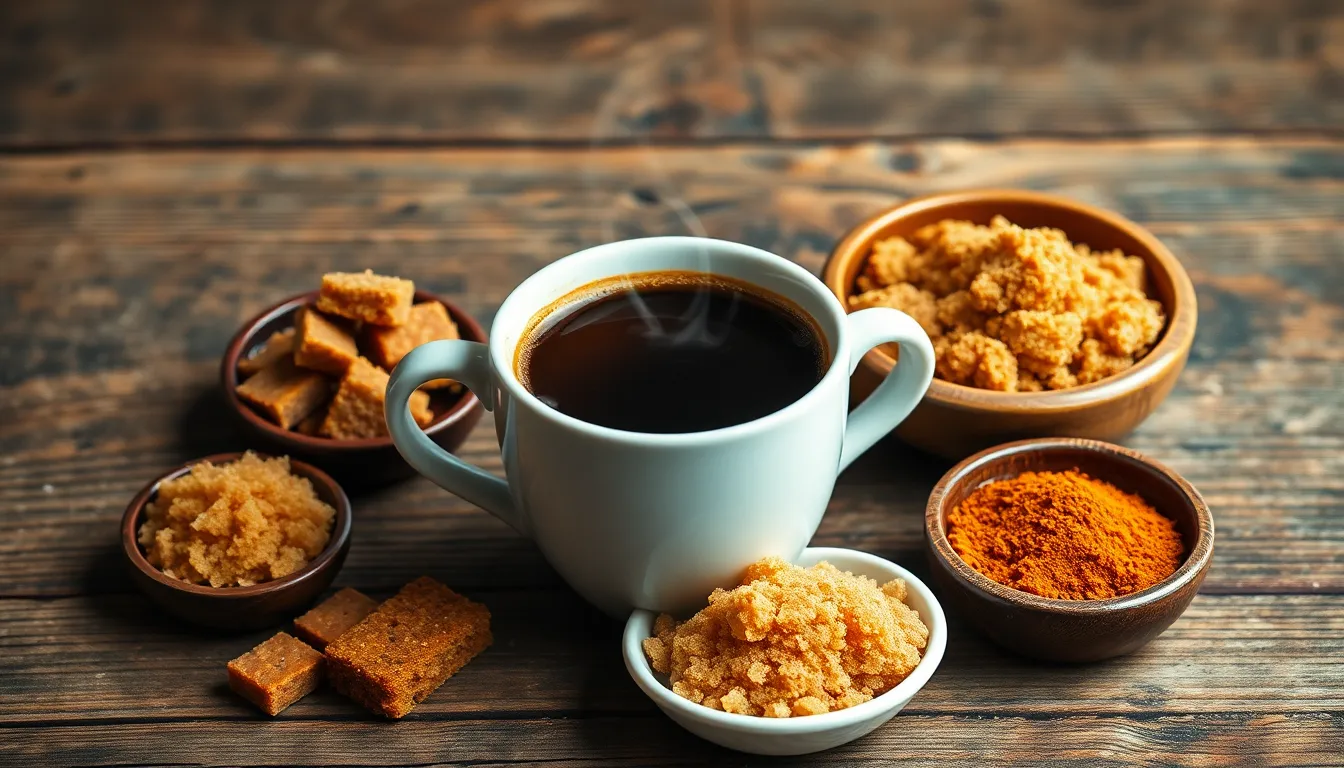Wondering if brown sugar in coffee might be your new morning game-changer? This rich, molasses-infused sweetener isn’t just for baking anymore—it’s transforming ordinary brews into extraordinary experiences for coffee lovers everywhere.
When you add brown sugar to your coffee, you’re not simply sweetening your cup. You’re introducing complex caramel notes that complement coffee’s natural bitterness in ways that white sugar simply can’t match. Whether you’re brewing a robust dark roast or a delicate light blend, brown sugar’s distinct flavor profile might be the secret ingredient your morning routine has been missing.
What Makes Brown Sugar Different From White Sugar
Brown sugar differs from white sugar primarily in its molasses content, which gives it distinctive characteristics. During processing, molasses is either retained in or added back to the sugar crystals, creating brown sugar’s moist texture and caramel-like flavor profile. This molasses content ranges from 3.5% in light brown sugar to 6.5% in dark brown sugar.
The production process separates these two sugars from the start. White sugar undergoes extensive processing to remove all molasses content, resulting in pure sucrose crystals with a neutral sweetness. Brown sugar maintains some of this natural molasses, preserving minerals like calcium, potassium, iron, and magnesium that are stripped from white sugar.
Flavor differences between these sugars are immediately noticeable in your coffee. Brown sugar introduces warm, toffee-like notes with subtle hints of caramel and butterscotch that complement coffee’s natural bitterness. White sugar provides straightforward sweetness without additional flavor complexity, making it a more neutral option.
Texture plays an important role in how these sugars dissolve in coffee. Brown sugar’s moisture content helps it melt more quickly into hot beverages compared to white sugar’s dry crystals. This quicker dissolution ensures your coffee maintains consistent sweetness from first sip to last.
Nutritional profiles show minimal differences, with both containing similar calorie counts. Brown sugar offers trace minerals from molasses but not in quantities important enough to provide substantial health benefits. Your choice between these sugars eventually comes down to flavor preference rather than nutritional advantage.
Flavor Profile Of Brown Sugar In Coffee
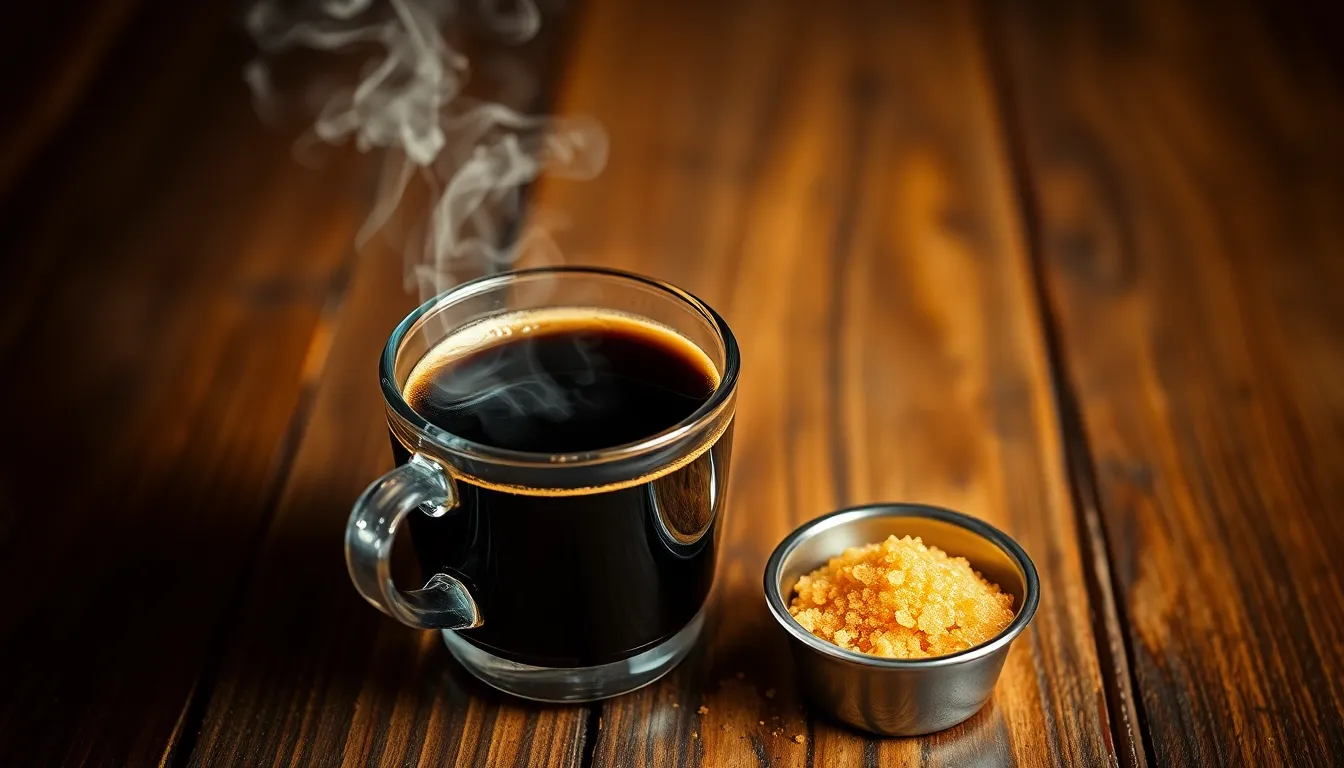
Brown sugar introduces a distinctive flavor profile to coffee characterized by deep caramel notes and warm molasses undertones. The molasses content, which white sugar lacks, creates a moist texture that dissolves easily while contributing rich toffee flavors. This natural complexity transforms your regular cup into something more sophisticated without requiring additional flavorings or creamers.
How Brown Sugar Enhances Coffee Taste
Brown sugar elevates your coffee experience beyond simple sweetness by adding layers of flavor complexity. The caramel and toffee notes blend seamlessly with coffee’s natural profile instead of merely masking it. These warm flavors effectively soften coffee’s inherent bitterness, resulting in a smoother, more balanced cup.
Coffee drinkers often notice that brown sugar creates a more indulgent mouthfeel compared to white sugar. The molasses components integrate with the coffee rather than sitting separate from it, producing a cohesive flavor that feels more sophisticated. Dark roasts particularly benefit from this enhancement as the rich molasses complements their robust character without competing against it.
Types Of Coffee That Pair Well With Brown Sugar
Dark roasted coffees form an exceptional partnership with brown sugar due to their complementary flavor profiles. The intense, sometimes smoky qualities of dark roasts harmonize with brown sugar’s caramel notes, creating a balanced experience where neither element overwhelms the other.
Coffees featuring natural caramel or nutty undertones receive important enhancement from brown sugar’s similar flavor spectrum. Brazilian and Colombian beans often exhibit these characteristics, making them perfect candidates for brown sugar sweetening. Single-origin coffees from Guatemala or Ethiopia with chocolate or fruity profiles also benefit from brown sugar’s complexity.
Specialty blends formulated with creamy or dessert-like profiles pair wonderfully with brown sugar. The molasses content amplifies existing sweet notes while adding dimension to the overall taste experience. Some artisanal roasters even incorporate brown sugar during the roasting process to achieve buttery, rich finishes that complement the natural flavors of their beans.
Health Considerations When Using Brown Sugar
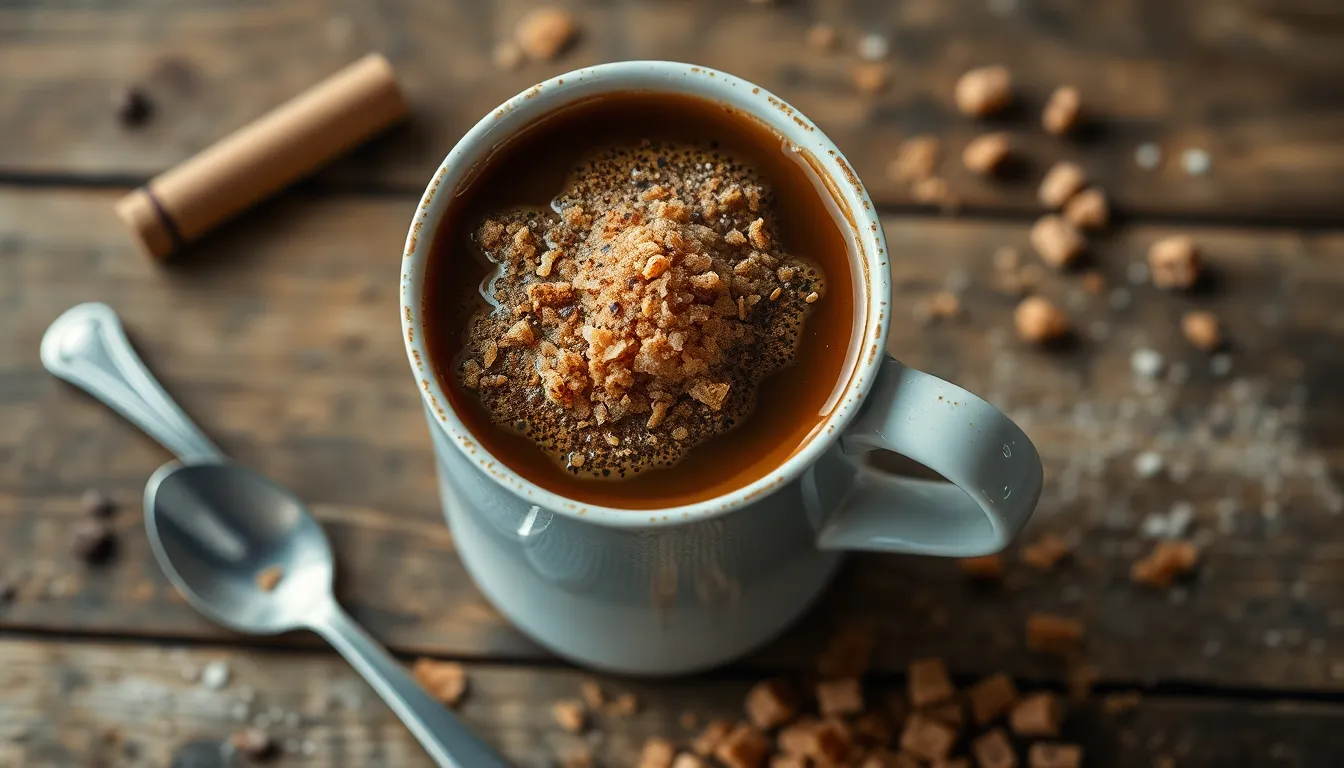
Brown sugar offers a distinct flavor experience in coffee, but comes with health implications similar to other sweeteners. Understanding these considerations helps you make informed choices about your daily coffee routine.
Nutritional Comparison With Other Sweeteners
Brown sugar differs only slightly from white sugar from a nutritional standpoint. A teaspoon of brown sugar contains 17 calories compared to white sugar’s 16 calories, making the difference negligible for most coffee drinkers. The glycemic index values are nearly identical as well—brown sugar ranks at approximately 64 while white sugar sits at around 65.
| Sweetener | Calories (per tsp) | Glycemic Index | Trace Minerals |
|---|---|---|---|
| White Sugar | 16 | ~65 | None |
| Brown Sugar | 17 | ~64 | Tiny amounts of calcium, potassium, iron (from molasses) |
The molasses content in brown sugar does contribute trace minerals like calcium, potassium, and iron, but these amounts are too minimal in a typical serving to provide important nutritional benefits. Your body won’t receive meaningful mineral supplementation from adding brown sugar to your coffee.
Adding any sugar to coffee increases your daily sugar intake, which can contribute to several health concerns. Excessive consumption links to weight gain, tooth decay, and elevated blood sugar levels. Regular high sugar intake raises your risk of developing insulin resistance and type 2 diabetes over time. Some sensitive individuals might experience immediate symptoms like shakiness and confusion, particularly those with blood sugar regulation issues.
The health implications between brown and white sugar remain virtually identical, making your choice primarily about flavor preference rather than nutritional advantage. Both sweeteners should be used moderately in your coffee to minimize potential health risks associated with sugar consumption.
How To Properly Add Brown Sugar To Coffee
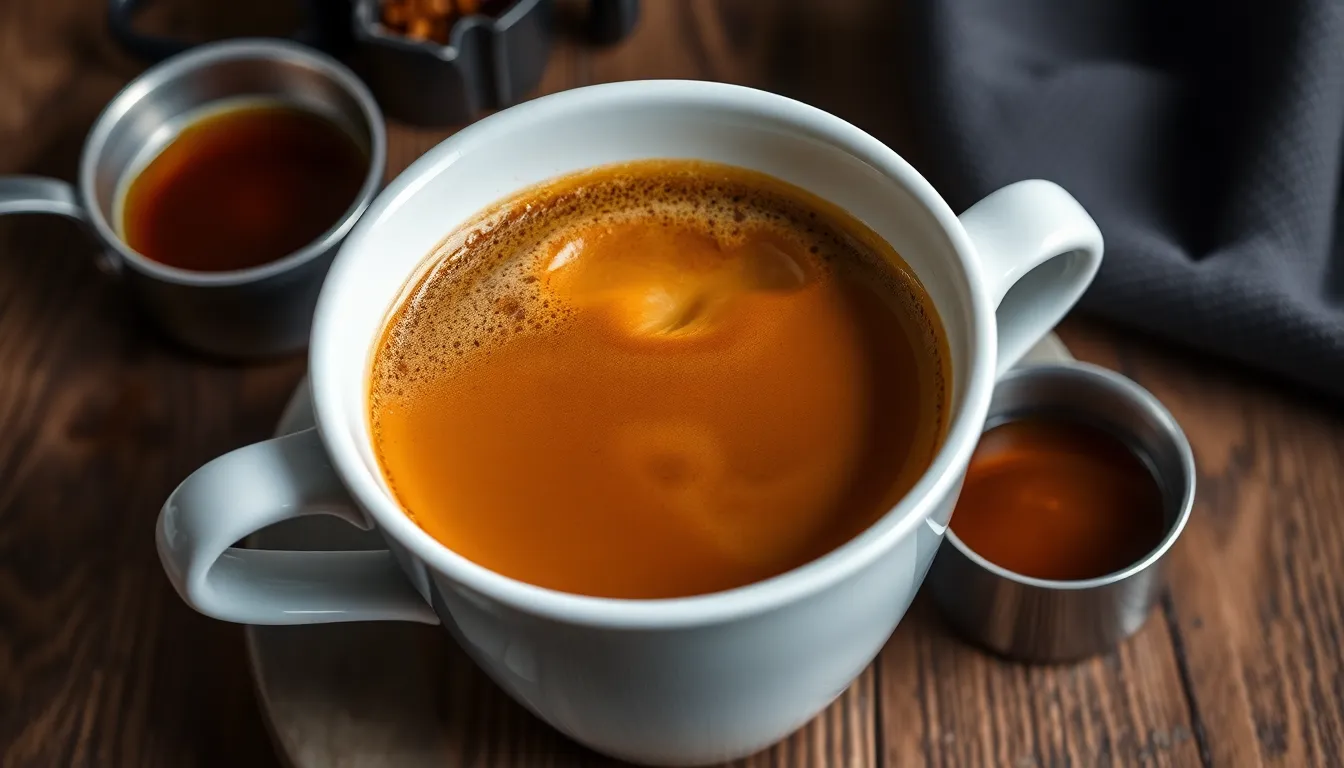
Brown sugar transforms coffee with its molasses-rich sweetness and caramel undertones. Adding it correctly ensures you get the perfect balance of flavor without unwanted grittiness or uneven sweetness in your cup.
Dissolving Techniques For The Perfect Cup
The key to incorporating brown sugar into coffee lies in proper dissolution. Brown sugar’s molasses content makes it dissolve more slowly than white sugar, requiring exact techniques for the best results.
Create a Brown Sugar Syrup
Making a simple syrup is the most effective method for adding brown sugar to coffee. Combine brown sugar with a small amount of water in a saucepan over medium heat. Stir continuously until the sugar completely dissolves and forms a smooth syrup. This pre-dissolved mixture blends seamlessly into both hot and iced coffee, preventing any sugar granules from settling at the bottom of your cup.
Brew Coffee Over Brown Sugar
For a simpler approach, place brown sugar directly in your empty cup before brewing. Pour hot coffee directly over the sugar, allowing the heat to naturally dissolve it. This method works particularly well with pour-over, French press, or drip coffee makers. Stir thoroughly after pouring to ensure complete dissolution and even sweetness throughout.
Heat and Temperature Considerations
Temperature plays a crucial role in dissolving brown sugar effectively. Hot coffee naturally dissolves sugar more efficiently than cooled coffee. For iced coffee preparations, always add your brown sugar to the hot coffee before cooling or adding ice. Alternatively, use the syrup method mentioned above to guarantee smooth integration into cold beverages.
Complementary Flavor Additions
Brown sugar pairs exceptionally well with warming spices. Adding a pinch of cinnamon, nutmeg, or cardamom enhances the molasses notes in the sugar. For a specialty brown sugar coffee experience, mix these spices directly into your sugar syrup or sprinkle them into your cup along with the brown sugar before brewing.
Stirring Techniques
Thorough stirring ensures even distribution of sweetness. Stir in a circular motion, reaching the bottom of the cup to incorporate any sugar that may have settled. For hot coffee, stirring for 15-20 seconds typically achieves complete dissolution. Iced coffee preparations may require additional stirring to overcome the challenge of lower temperatures.
Creative Coffee Recipes Using Brown Sugar
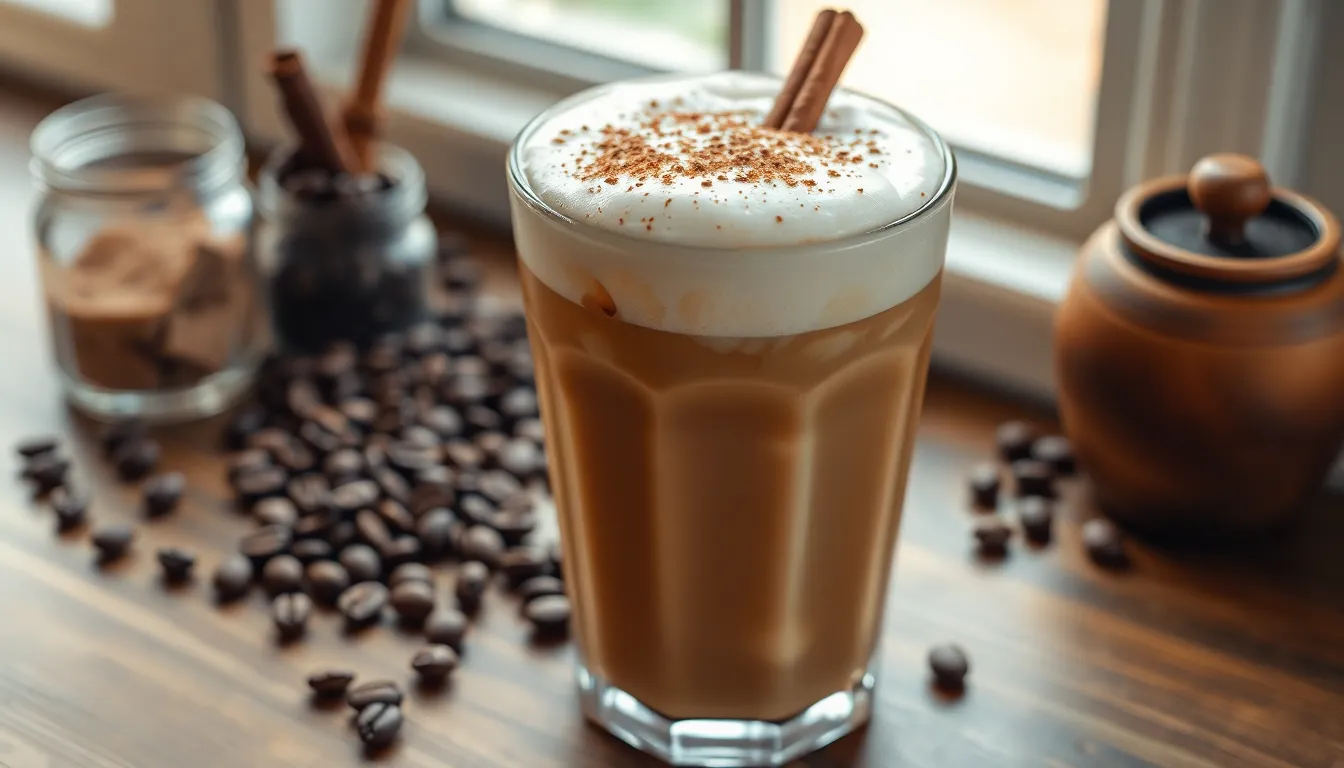
Brown sugar transforms ordinary coffee into exceptional drinks with its rich, caramel-like flavor profile. These creative recipes showcase how this distinctive sweetener can elevate your coffee experience beyond the ordinary.
Iced Brown Sugar Latte with Shaken Espresso
This luxurious coffee creation combines freshly brewed espresso with a homemade vanilla brown sugar syrup infused with warm cinnamon notes. The syrup forms the flavor foundation by boiling brown sugar with a cinnamon stick and vanilla extract until perfectly dissolved. Once prepared, vigorously shake the espresso and syrup with ice to create a frothy texture, then pour this mixture over cold milk for a refreshingly creamy, spiced iced latte. The combination of brown sugar’s molasses undertones with the aromatic cinnamon creates a balanced sweetness that complements the espresso’s natural bitterness.
Simple Iced Brown Sugar Coffee
This straightforward recipe offers big flavor with minimal effort. Start with brewed coffee cooled to room temperature, then mix in brown sugar syrup and a light dusting of cinnamon. Add your preferred milk—dairy or plant-based alternatives like oat or almond milk work beautifully—and serve over ice for a refreshing treat. For extra indulgence, top your creation with frothed milk to add textural contrast and visual appeal. The brown sugar’s deep caramel notes shine through particularly well in this simple preparation, allowing you to appreciate its distinctive flavor profile.
Easy Brown Sugar Coffee
For coffee lovers seeking convenience without sacrificing flavor, this method delivers impressive results in minutes. Simply brew hot coffee directly over brown sugar, allowing the heat to dissolve the sweetener completely. Pour this sweetened coffee over ice, add a splash of half and half for creaminess, and finish with optional cinnamon for aromatic complexity. The direct brewing method infuses the coffee with brown sugar’s rich molasses flavor from the start, creating an integrated taste experience rather than just adding sweetness at the end.
Brown Sugar Coffee Syrups And Foams
Brown sugar syrups add consistent sweetness and complex flavor to coffee drinks while dissolving perfectly every time. Create basic brown sugar syrup by simmering equal parts brown sugar and water until fully dissolved, then cooling and storing in the refrigerator for up to two weeks. Enhance your syrup with cinnamon sticks, vanilla extract, or even tea bags during simmering for additional flavor dimensions.
Brown sugar vanilla syrup delivers warm, aromatic sweetness that pairs exceptionally well with iced lattes and shaken coffee drinks. The vanilla amplifies the caramel notes in the brown sugar while adding its own distinctive fragrance and flavor profile.
Coffee foam made with brown sugar adds both flavor and textural contrast to your beverages. Froth milk with a small amount of brown sugar syrup using a handheld frother or steam wand to create a sweet, velvety topping that slowly integrates with your coffee as you drink. This technique enhances both the mouthfeel and flavor experience, turning an ordinary coffee into something truly special.
Conclusion
Brown sugar offers a unique dimension to your daily coffee that white sugar simply can’t match. With its rich molasses content creating caramel notes and a velvety mouthfeel it transforms ordinary brews into extraordinary experiences.
Whether you’re enjoying a dark roast Colombian blend or experimenting with brown sugar syrup in an iced latte the possibilities are endless. The warm toffee undertones complement coffee’s natural profile while softening bitterness.
Remember that while flavor is the primary benefit the nutritional differences are minimal so choose based on taste preference. With proper dissolution techniques and a bit of creativity you’ll discover a whole new industry of coffee enjoyment that might just make you leave white sugar behind for good.
Frequently Asked Questions
Why is brown sugar better for coffee than white sugar?
Brown sugar enhances coffee with complex caramel notes and molasses undertones that white sugar lacks. It balances coffee’s natural bitterness while adding depth and richness to the flavor profile. The moisture in brown sugar also helps it dissolve more quickly in hot beverages, ensuring consistent sweetness throughout your cup. While nutritionally similar to white sugar, brown sugar transforms ordinary coffee into a more sophisticated, smooth experience without needing additional flavorings.
Does brown sugar have any nutritional advantages over white sugar?
Not significantly. Brown sugar contains trace minerals from molasses that white sugar lacks, but these amounts are too minimal to provide meaningful nutritional benefits. Brown sugar has approximately 17 calories per teaspoon versus white sugar’s 16 calories, and their glycemic indexes are nearly identical (64 versus 65). The choice between the two should be based on flavor preference rather than health considerations, as both should be consumed in moderation.
Which types of coffee pair best with brown sugar?
Dark roasted coffees pair exceptionally well with brown sugar, as the rich molasses complements their robust character. Brazilian and Colombian beans with natural caramel or nutty undertones are also excellent candidates. Specialty blends with creamy or dessert-like profiles benefit greatly as brown sugar amplifies their sweet notes. Some artisanal roasters even incorporate brown sugar during roasting to achieve buttery, rich finishes that enhance their beans’ natural flavors.
What’s the best way to add brown sugar to coffee?
For optimal flavor, ensure brown sugar dissolves completely. Consider creating a brown sugar syrup by heating it with water, or brew coffee directly over brown sugar. Hot coffee works best for dissolution. Stir thoroughly to distribute sweetness evenly throughout your drink. For enhanced flavor, add complementary warming spices like cinnamon or nutmeg. When making iced coffee, dissolve the sugar in hot coffee first before cooling to avoid grittiness.
Can I make brown sugar syrup for my coffee?
Absolutely! Combine equal parts brown sugar and water in a saucepan, bring to a gentle simmer while stirring until dissolved, then cool completely. For extra flavor, add vanilla extract or spices like cinnamon during cooking. This syrup provides consistent sweetness in both hot and cold coffee drinks, eliminating dissolution issues. Store in a sealed container in the refrigerator for up to two weeks. This method transforms ordinary coffee into cafe-quality beverages with minimal effort.
Will brown sugar change the mouthfeel of my coffee?
Yes, brown sugar creates a more indulgent, velvety mouthfeel compared to white sugar. Its molasses content adds a subtle thickness that makes coffee feel richer and more luxurious on the palate. This effect is particularly noticeable in dark roasts, where brown sugar softens harsh edges while enhancing body. The result is a smoother, more balanced cup with a pleasant lingering sweetness that white sugar simply cannot replicate.
Is brown sugar suitable for all coffee brewing methods?
Brown sugar works well with virtually all brewing methods, though results may vary. It’s particularly excellent in methods that allow for thorough dissolution, such as drip coffee, French press, and espresso-based drinks. Pour-over methods benefit when the sugar is added to the cup before brewing directly over it. Cold brew methods require pre-dissolving the sugar in a small amount of hot water first. Adjust quantities based on your brewing method’s intensity.
Can I use brown sugar in iced coffee drinks?
Definitely! Brown sugar adds exceptional flavor to iced coffee drinks, though proper dissolution is key. Either use a pre-made brown sugar syrup or dissolve the sugar in hot coffee before cooling. For a refreshing twist, try the Iced Brown Sugar Latte with Shaken Espresso recipe, which combines espresso with cinnamon-infused brown sugar syrup. The caramel notes of brown sugar complement cold coffee particularly well, creating a refreshing yet indulgent experience.

